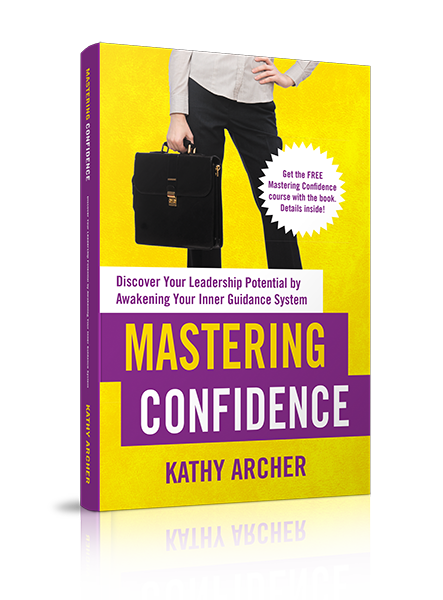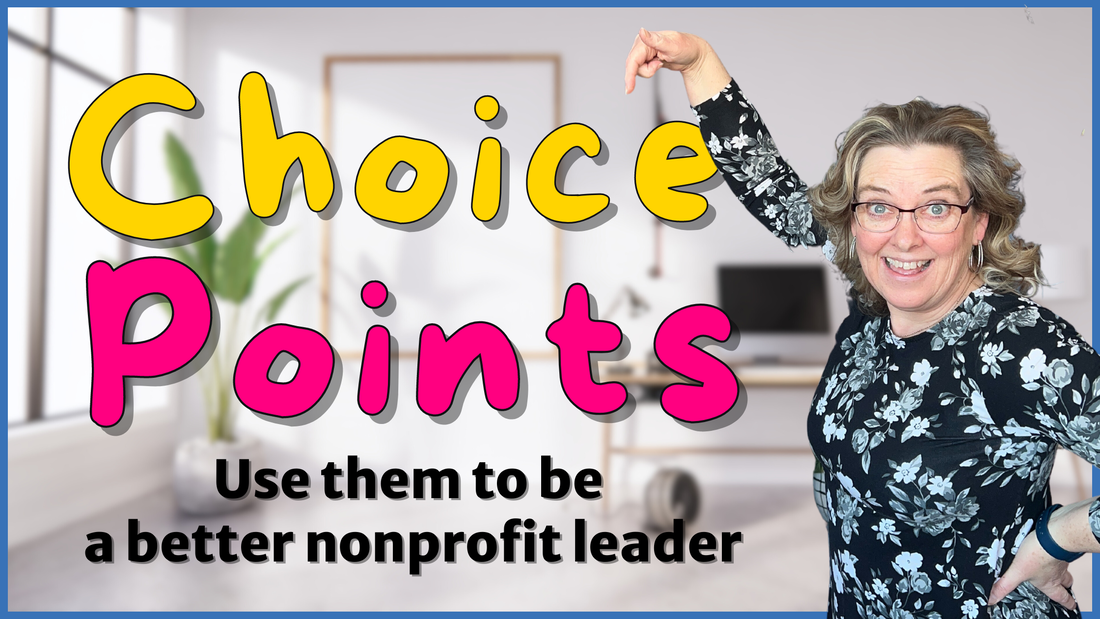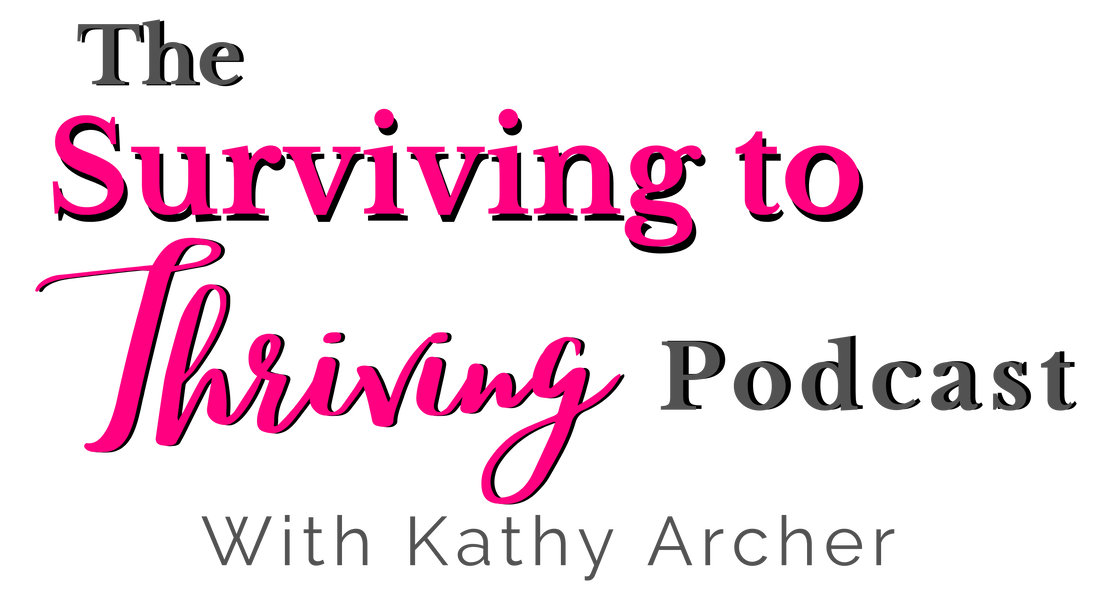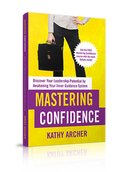|
Choice points. You have them, but are you using them to be a better leader? Choice Points 101
🟪 A choice point is... A choice point is an opportunity to choose what you are saying or not saying, what you are doing or not doing, and, most importantly, who you are being in the process of making that decision and acting on that decision. Choice points are critical for leaders to develop strong character Nonprofit leaders that lead with integrity, authenticity, and strong character lead with confidence and competence and feel in control of what is happening inside and around them. When you lead with that strength of character, you create an engaged team with meaningful relationships who do impactful work. Therefore, developing our character is fundamental to good leadership. Developing your character is multifaceted. However, one aspect that is often overlooked is the art of decision-making. Throughout your days, you encounter numerous choice points that shape how your day goes, the development of your relationships and the impact of your work. However, more often than not, we remain unaware of the existence of many of our decision points. To lead with authenticity and integrity, nonprofit women leaders must cultivate awareness of their choice points and embrace decision-making intentionality using criteria aligning with their values and goals. How unaware of your choice points are you? Far too often, you default to not really making a decision. Your decision points often go unnoticed in the hustle and bustle of daily responsibilities while running your nonprofit. They may appear inconsequential at first glance, but their cumulative impact can be profound. 🟧 The decisions we default to: We often make decisions by default. Rather than making a decision, we put our attention, focus and resources into reacting to:
When we aren't making choices... We tend to follow this path: If A happens, I do B. That's not a decision 👉🏻 Just because you get invited to a meeting doesn't mean you need to attend it. 👉🏻 Just because it came into your inbox doesn't mean you are the one to deal with it or you need to deal with it today. 👉🏻 Just because someone asks for "just a minute," you don't have to say yes. We say we are making a choice, but really we aren't deciding anything. So, when we say the choice is either I do the work or the work doesn't get done, that's not a choice. That is a victim mentality. Or if we say, either I stay late or do it in the morning. What were you deciding? Which punishment to take? It's an either/or, with neither option being optimal. They're both sides of the same coin. You've given your power away! What often happens is we're not really making a decision. Instead, we are making excuses about why we're doing what we're doing or why we are doing it. We are pointing fingers (the funder needs it), resigning to martyr syndrome (I'm the only one who can do it) or getting caught up in survival mode just running around the hampster wheel (another day...) By neglecting to recognize these decision points, we as leaders miss opportunities to cultivate our character and steer our organizations and teams in the right direction. 🙋🏼♀️ It's time to cultivate your awareness of decision points Leading with authenticity and strong character requires a shift from reactive to proactive decision-making. Instead of simply reacting to circumstances, intentional leaders make conscious choices that align with their beliefs, core values and long-term vision. 🟨 Decisions drive character development But they must be: ✅ Done deliberately ✅ Made intentionally ✅ From a place of consciousness To unlock the power of decision-making, cultivating awareness is paramount Taking time for self-reflection and introspection via The Inner Guidance Cycle allows leaders to identify decision points that might have otherwise slipped through the cracks. You can seize these pivotal moments and harness them for character development by heightening your awareness. Using The Inner Guidance Cycle to make intentional decisions When you intentionally make a decision, you must first PAUSE, slow down and then PONDER. By contemplating the paths ahead of you, you will PIVOT, realizing it is not an either/or approach, but you will see the options, opportunities and outcomes you can create. Finally, after purposefully deciding, you'll PROCEED back into action. 🟦 A choice point is an opportunity for you to choose: ✔️ What you are saying or not saying ✔️ What you are doing or not doing ✔️ Who you are being in the process 🔀 You need to develop a decision-making framework with decision-making criteria To make more intentional decisions, you need to construct a decision-making framework. This framework serves as a guide, offering a structured approach to navigating complex choices. This way, you can ensure that your decisions align with your beliefs, values, goals, and the greater purpose of the nonprofit you are leading. Your framework will include considerations to ponder when making your choice. You'll want to run your options around criteria like your beliefs, values, time, resources, strengths, interests, team pressure points, etc. Using these filters will help you choose wisely with a better sense of your current and future perspectives. 🆘 In the Decisive Decision-Making course in The Training Library, you'll find a framework you can use. Questions to ensure you are making decisions with your strengths of character When you are pondering your options, you'll want to ask these questions: Is this action/decision a statement of
It's all about the Inner Work! Learning to lead with authenticity and strong character is a transformative journey for you as you lead your nonprofits. It's a personal development journey that will profoundly affect your leadership. It requires you to grow from the inside out! By recognizing the power of choice points, cultivating your awareness of where they show up, and embracing those decision points intentionally, you can navigate your leadership with purpose and integrity. Developing decision-making criteria based on values, time, resources, interests, skills, and expectations provides a solid foundation for making better choices that align with your character and foster your growth and that of your team and organization. P.S. If you want the decision-making framework worksheet, you'll find it inside The Training Library in the course Decisive Decision Making.
0 Comments
Your comment will be posted after it is approved.
Leave a Reply. |

Available on Amazon
Archives
May 2024
|
|
Leadership TRAINING for Nonprofit Leaders
Become a confident and competent nonprofit Leader: Join The Training Library membership Executive and Leadership COACHING Leadership Coaching for Nonprofit Executives, Leaders and ManagerCoaching |
PODCAST for Nonprofit Leaders
The Surviving to Thriving podcast: Strategies, systems and support to lead your nonprofit with confidence FREE RESOURCES to Grow your Leadership Skills Free Leadership Training Resources, Worksheets and Templates |
Become a CONFIDENT LEADER
|




 RSS Feed
RSS Feed
